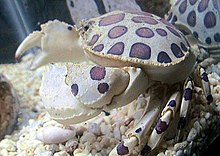|
Hepatus epheliticus
Hepatus epheliticus, known by various names, including the calico crab (not to be confused with Ovalipes ocellatus) and Dolly Varden crab, is a species of crab. It lives in shallow water in the western Atlantic Ocean from the Chesapeake Bay to the Dominican Republic. It has a 3-inch (76 mm)–wide carapace adorned with large red spots with darker outlines. DescriptionHepatus epheliticus grows to 3 inches (76 mm) across the carapace,[2] which is covered in large patches of red color, which may join up into lines or other patterns.[3] The spots are outlined in a darker color; in some crabs, only the darker rings are visible.[4] DistributionThe range of H. epheliticus extends from the Chesapeake Bay southwards, including the whole of the Gulf of Mexico, and as far south as Jamaica and the Dominican Republic.[3] Ecology and life cycleHepatus epheliticus lives at depths of up to 46 m (151 ft) on sandy and muddy substrates.[3] It often carries the sea anemone Calliactis tricolor on its back,[5] or lies buried in the sand, with only its eyes exposed.[6] Reproduction occurs in summer, as shown by the occurrence of "berried" (egg-bearing) females.[5] The eggs are held by the female until they hatch; there are five planktonic zoea stages.[7] TaxonomyHepatus epheliticus was first described, under the name Cancer epheliticus, by Carl Linnaeus in his 1763 work Centuria Insectorum,[8] based on specimens from Carolina sent to him by Alexander Garden.[9] Subjective synonyms of H. epheliticus include Cancer decorus, published by Johann Friedrich Wilhelm Herbst in 1803, and Cancer vanbenedenii, published by Jan Adrian (or Janus Adrianus) Herklots in 1852.[1] Hepatus epheliticus is known by several common names, including calico box crab,[3] calico crab,[4] Gulf calico crab,[6] and Dolly Varden crab.[4] References
External links
Information related to Hepatus epheliticus |
||||||||||||||||||||||||||||||||||
Portal di Ensiklopedia Dunia
